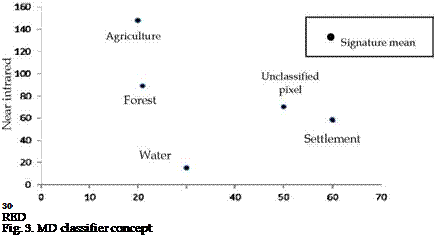Model based classifiers are run using basic statistical theories like mean, variance and standard deviation of the dataset. The most used ones at the literatures are supervised MLC, MD, LDA and unsupervised k-means.

The minimum distance classifier is used to classify unknown image data to classes which minimize the distance between the image data and the class in multi-feature space. The distance is defined as an index of similarity so that the minimum distance is identical to the maximum similarity. If a pixel closer than to mean of a signature pixels, it classifies as same as nearest one. In figure 3, the nearest signature mean to unclassified pixel is settlement, thus it will be assigned to settlement class according to MD classifier.
The MLC procedure is based on Bayesian probability theory. Using the information from a set of training sites, MLC uses the mean and variance/covariance data of the signatures to estimate the posterior probability that a pixel belong to each class. MLC procedure is similar to MD with the standardized distance option. The difference is that MLC accounts for intercorrelation between bands. By incorporating information about the covariance between bands as well as their inherent variance, MLC procedures what can be conceptualized as an elliptical zone of characterization of signature. It calculates the posterior probability of belonging to each class, where the probability is highest at mean position of the class, and falls off in an elliptical pattern away from the mean.
The LDA classifier conducts linear discriminant analysis of the training site data to form a set of linear combination that expresses the degree of support for each class. The assigned class for each pixel is then that class which receives the highest support after evaluation of all functions. These functions have a form similar to that of a multivariate linear regression equation, where the independent variables are the image bands, and the dependent variable is the measure of support. In fact, the equations are calculated such that they maximize the variance between classes and minimize the variance within classes. So that class separation becomes easier.
In k-means unsupervised technique, K-means clustering technique is used to partition a n – dimensional imagery into K exclusive clusters. This method begins by initializing k centroids (means), then assigns each pixel to the cluster whose centroid is nearest, updates the cluster centroids, then repeats the process until the k centroids are fixed. This is a
|
|||
|
|||
|
|
||
|
|||
|
|||
|
|||
|
|||
|
|||
|



